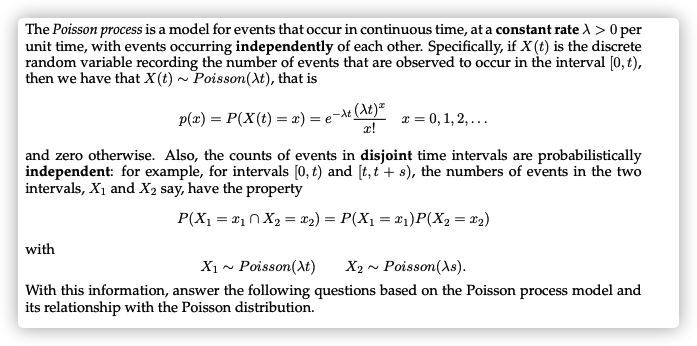(a) Radioactive particles are detected by a counter according to a Poisson process with rate parameter λ = 0.5 particles per second. What is the probability that two particles are detected in any given one second interval ?
(a) Radioactive particles are detected by a counter according to a Poisson process with rate parameter λ = 0.5 particles per second. What is the probability that two particles are detected in any given one second interval ?
A First Course in Probability (10th Edition)
10th Edition
ISBN:9780134753119
Author:Sheldon Ross
Publisher:Sheldon Ross
Chapter1: Combinatorial Analysis
Section: Chapter Questions
Problem 1.1P: a. How many different 7-place license plates are possible if the first 2 places are for letters and...
Related questions
Question
(a) Radioactive particles are detected by a counter according to a Poisson process with rate parameter λ = 0.5 particles per second. What is the probability that two particles are detected in any given one second interval ?
(b) Page visits to a particular website occur according to a Poisson process with rate parameter λ = 20 per minute. What is the expected number of visits to the website in any given one hour period ?
(c) What is the probability that the time of the first event that is observed to occur in a Poisson process with rate λ per unit time, after initiation at t = 0, occurs later than time t = t0, for fixed value t0 ? Justify your answer.

Transcribed Image Text:The Poisson process is a model for events that occur in continuous time, at a constant rate ) > 0 per
unit time, with events occurring independently of each other. Specifically, if X (t) is the discrete
random variable recording the number of events that are observed to occur in the interval [0, t),
then we have that X (t) ~ Poisson(At), that is
p(x) = P(X(t) = x) = e¬At (At)“
x!
x = 0, 1, 2, ...
and zero otherwise. Also, the counts of events in disjoint time intervals are probabilistically
independent: for example, for intervals [0, t) and [t, t'+ s), the numbers of events in the two
intervals, X1 and X2 say, have the property
P(X1 = #10X2 = x2) = P(X1 = #1)P(X2 = x2)
%3D
with
X1 ~ Poisson(At)
X2 ~ Poisson(As).
With this information, answer the following questions based on the Poisson process model and
its relationship with the Poisson distribution.
Expert Solution
This question has been solved!
Explore an expertly crafted, step-by-step solution for a thorough understanding of key concepts.
Step by step
Solved in 2 steps with 2 images

Recommended textbooks for you

A First Course in Probability (10th Edition)
Probability
ISBN:
9780134753119
Author:
Sheldon Ross
Publisher:
PEARSON


A First Course in Probability (10th Edition)
Probability
ISBN:
9780134753119
Author:
Sheldon Ross
Publisher:
PEARSON
